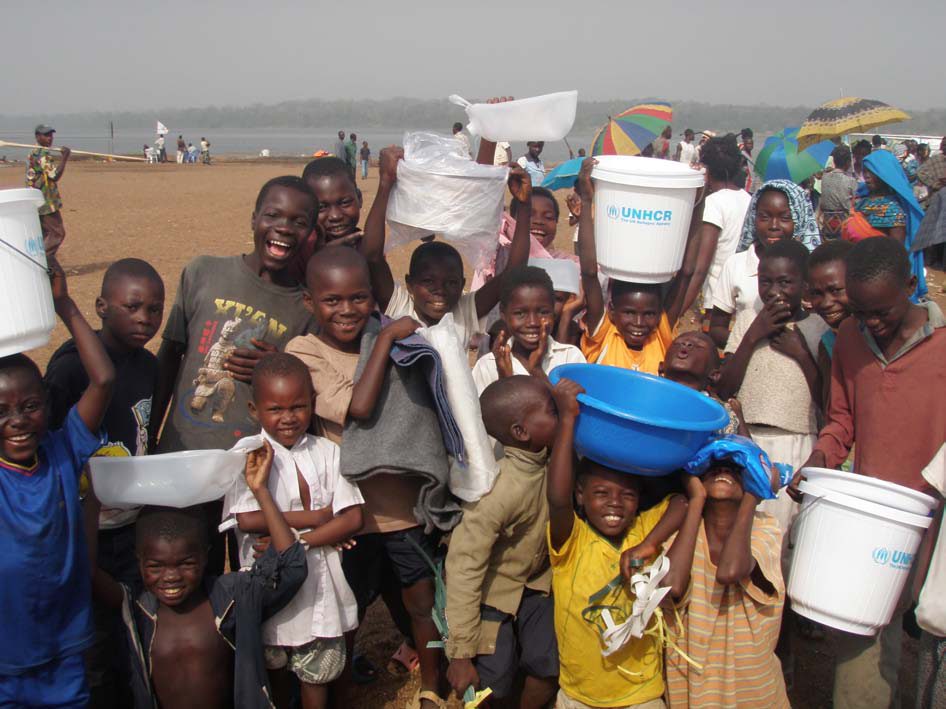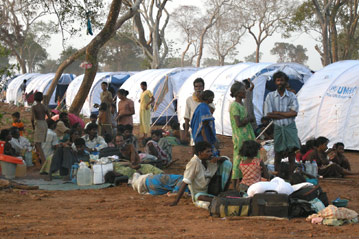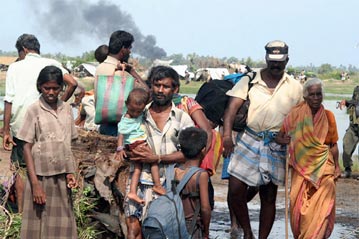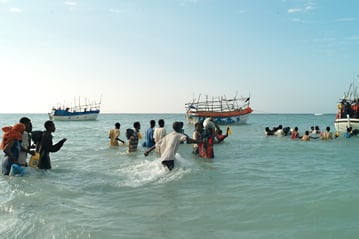Harvest time in Zimbabwe, refugees help themselves
Harvest time in Zimbabwe, refugees help themselves

TONGOGARA REFUGEE CAMP, Zimbabwe, 19 Feb (UNHCR) - Siri Kirogi moved through the tall stalks, pulling weeds from the irrigation channels and filling a sack with ripe ears of maize.
Although only 16 years old, Siri and her younger brother are caring for the plot assigned to their family at Tongogora Refugee Camp when not attending school. She also grows vegetables in a small garden beside their home in the camp.
Siri arrived at the camp in 2004, a refugee fleeing the violence in her native Democratic Republic of the Congo (DRC). She was accompanied by three brothers, including the eldest who is now 20. In the jargon of the UN refugee agency, they were unaccompanied minors; to most people they were simply orphans whose parents had been killed in the DRC's wars.
The plot in the field and the vegetable garden are far from enough to feed the four young refugees but they do provide a vital supplement. Rations were reduced at Zimbabwe's only refugee camp during the last year, although they still meet the daily requirement of 2,100 Kcal.
That was not just an economy measure. As in other countries, UNHCR is pursuing a policy of making long-time refugees as self-reliant as possible - providing essential aid but ensuring it does not create a culture of dependency.
"This field is important because there is no other source of food but a vegetable patch and the rations," Siri said as she adjusted the plastic pipes the refugees use to siphon water into the field from concrete-lined ditches.
The 2,100 refugees at the camp in eastern Zimbabwe are almost all from the Great Lakes area - DRC, Rwanda and Burundi - and show little enthusiasm for returning home. The 20 hectares of maize that are now being harvested provide a welcome supplement to their diet. Most of the fields will be planted next with beans.
A further 40 hectares is available but will require extra investment. The land, located in one of the driest areas of Zimbabwe and with poor sandy soil, depends on irrigation water brought from a river 15 kilometres away.
It was given for the use of refugees when Tongogara was first established in the 1970s to house refugees fleeing the civil war in Mozambique, just over the eastern border. The camp was later closed but reopened in 1997 to house refugees driven out of the Great Lakes area.
The refugees have been using the fields on the outskirts of the refugee camp for several years but UNHCR, through its local partner World Vision, decided a year ago to focus on improving agriculture. After receiving expert advice to develop the fields and improve agricultural skills, the refugees said yields this year have soared.
"I was a tailor but now there's no work for me," said Bizimungu Dieudonne, who arrived in 2003 from Burundi and was carrying a sack of maize on the back of his bicycle. "There is no option. That is why I am doing this. We have finished growing maize and the manager says there will be a meeting to discuss what we grow next."
Each family gets a plot of 0.08 hectare - enough to grow about 80 kg of maize. Dieudonne said it would enhance the diet of his five children for the next two months. About 250 of the 650 family units in the camp have plots and more would like to participate. Eight local Zimbabwean families have been included, reducing potential tension. However, while the area under cultivation can be increased somewhat, refugees will continue to need rations.
"Zimbabwe is a very small country and demand for land is very high. The opportunities for refugees are very limited. Those who want to do agriculture will not get enough land," said Tapiwa Huye, a field officer with World Vision. "But the population of refugees has now seen the value of agriculture. They had feared it was a way to get them off of rations but now many want to join the project."
The economic problems in Zimbabwe and sensitivity over land present formidable obstacles to full local integration of refugees. A few refugees each year are resettled to third countries like Canada, Australia and the United States. UNHCR wants the remainder to be as self-sufficient as possible while awaiting a lasting solution.
"The farm plots don't end the problem. But at least they can supplement their rations," said Jennifer Msimbo, a UNHCR community services assistant who lives at the camp and recognises the danger of dependence on handouts. "And in the long-run the refugees are expected to go back home."
By Jack Redden in Tongogara Refugee Camp, Zimbabwe








